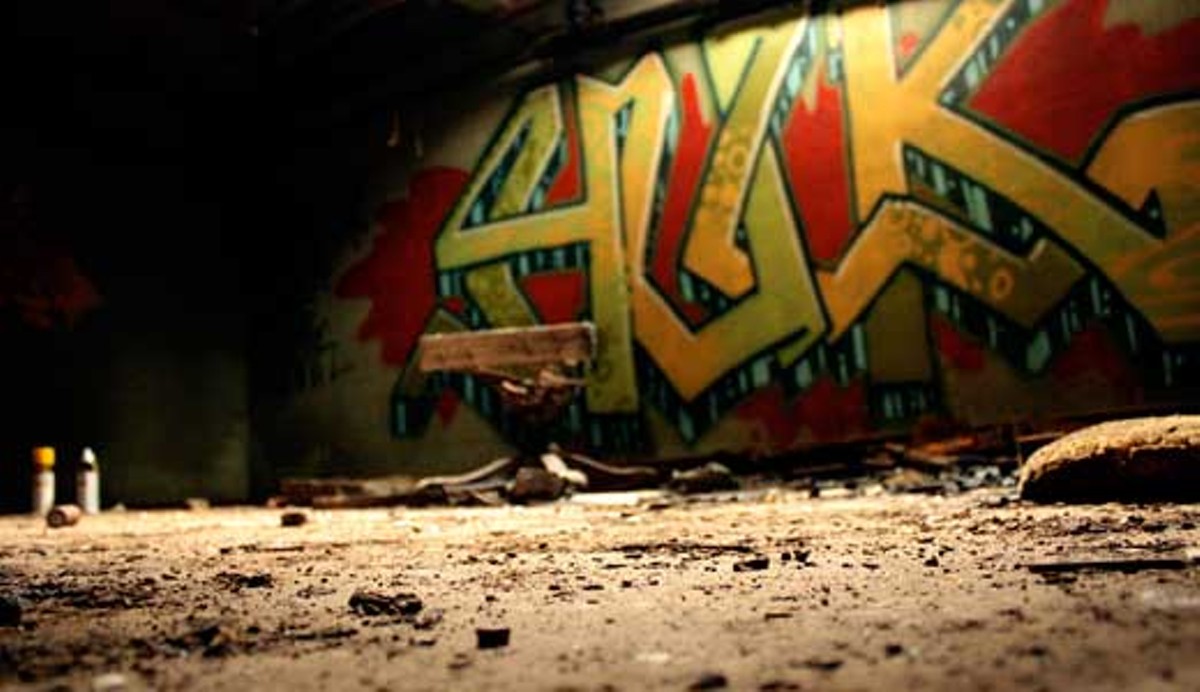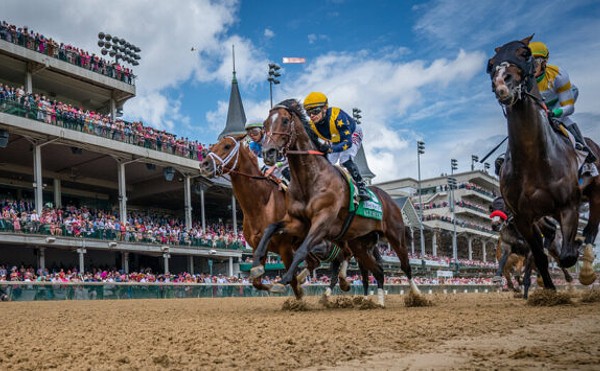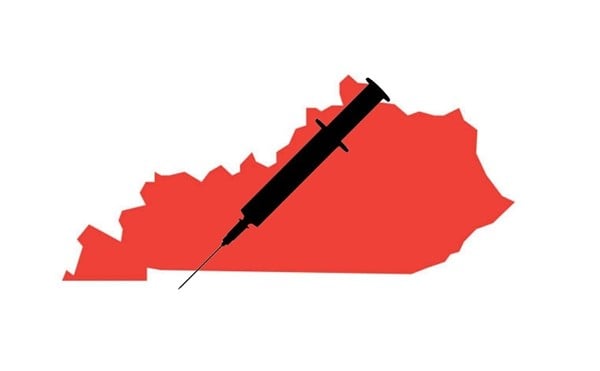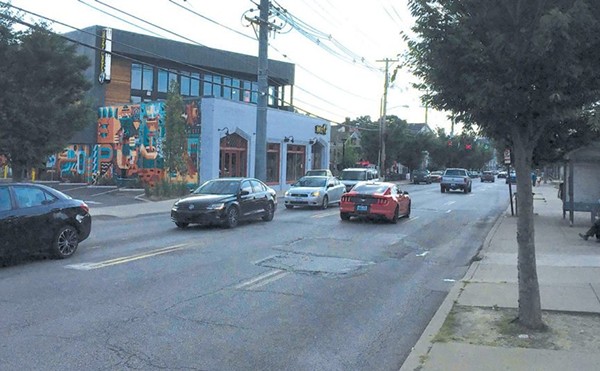A train blows its whistle in staccato 1-2-3 times in the distance. The expansive industrial park with its skeletal debris and hollow warehouses is otherwise quiet.
Orange city lights reflect in passing rain clouds — gentle, safe illumination, like a child’s nightlight. Still, it’s dark, so it’s hard to see. When a 20-year-old, whose urban explorer name is “Pandamonium,” or “Panda” for short, clicks on her headlamp, it wheezes to life.
Our group of four spots what looks like a fallen water tower on its side.
“How loud was that when it fell?” asks “Dante,” a 21-year-old fellow explorer. We walk into a cavernous white building weeping rust, raindrops echoing. Inside, we maneuver around a maze of piping. Electrical switch panels lie exposed, their doors splayed open. Ash sits in a row of furnaces.
“We believe this is a power plant,” Dante whispers. “As far as we know it’s not used … but it could be.”
“It’s pretty old,” Panda counters as she whips out an iPhone for its emergency scanner app. It lets them listen in on police radio traffic, ears perked for reports of trespassers. Panda’s dad is a retired cop.
She stops and marvels at what looks like two airplane engines, their interiors mercilessly shredded.
“When we go exploring,” she says, “this is like our jackpot.”
Panda and Dante’s legs, thin from hours of exploration, start a percussive beat as we climb three floors of metal stairs in single file. A breeze sneaks through windows with veins of shattered glass. Once at the top, Dante leads us along a catwalk, suddenly freezing. “Woah!”
He shines a flashlight on a hole in the grated flooring, not large enough for a body to fall through, but welcoming an ankle or leg to mangle.
Urban exploration involves seeking out and breaking into abandoned buildings, homes, transit tunnels, underground drains, and other deserted spaces. In Europe, catacombs, closed to the public, are considered gold. It’s not a new phenomenon, but over the past decade, the unorthodox and sometimes risky pastime has become increasingly popular thanks to the Internet, with individual curiosity congealing into an online community of urban explorers who tiptoe into the forbidden together.
Urban explorers from across the globe flock to websites devoted to the practice, the most popular being www.uer.ca, which went live in 2002 and now has more than 40,000 members. Meet-up times, convention invitations, trespassing tales, and photos all have a home here, as does a guide to “abandonment fauna.” An excerpt:
Crackheads — Native Habitat: Warehouses — Inherent risk: Murder.
Hipsters — Inherent Risk: Trust Funds — Identified by: PBR, eccentric facial hair.
The website inspired Dante and Panda’s team, Louisville Urban eXploration, or LUX, about a year ago. LUX members follow the rules codified by urban explorers before them: no drinking, no vandalism, no stealing, and most importantly, stay alert.
Dante says their only injury stemmed from a careless participant who fell into a shallow hole. She’s since been banned.
Backpacks carry flashlights, cameras, first-aid kits ready for large cuts, or a blister the size of a ladybug. Occasionally these half-dead buildings demand that they wear respirators to protect from asbestos. And there’s always the concern of chemicals.
Panda and Dante admit their Friday and Saturday nights aren’t typical, but acting as vigilante documentarians of a wilting industrial age has its appeal, especially when there’s a flourishing network of the like-minded.
On LUX’s rudimentary website, member Ninjalicious penned this explanation:
We jump fences not meant to be crossed, open doors not meant to be unlocked, break rules that authority arbitrarily set for our “safety.”
Armed with nothing more than cameras and flashlights, for the sake of exploring and appreciating the unseen parts of our city …
Like any other tour group, we take only pictures, leave only footprints.
It’s a drizzly Sunday evening when we gather at Mid-City Mall on Bardstown Road, the meet-up point for the night’s exploration. Panda straightens her knit cap with panda ears covering her black-cherry colored hair. Dante hoists his backpack on, belting a strap around his wiry waist.
“Panda, you have mashed potatoes all over you,” he laughs, staring at a dried smear on her pea coat.
“I knew it,” she giggles, scratching away the flakes of her misplaced dinner.
Panda and Dante make up two-thirds of the explorers at LUX’s nucleus. Dante is admittedly paranoid. Panda is more practical. And then there’s Eschaton — agile as a spider, resourceful as MacGyver. He’s also the one in the crew who, after finding a decaying building, digs into the archives to find its history. All this is second-hand information, though. Eschaton is weary of new explorers and, therefore, isn’t on tonight’s trek.
“He’s been at Waverly and the industrial park today. He’s been exploring all day,” Dante says, tossing shaggy bangs from his wire-framed eyeglasses.
LUX has grown to only about 10 people. And while their names allude to a crusty, anarchist existence, at least in this group, they’re chosen more out of cursory catchiness than ideology.
Panda rhymes with her real name.
Dante thought of his while waiting in line at Lazer Blaze.
Most in their group are college-aged. Dante is studying computer network administration. Panda wants to major in architecture.
“You ready?” Dante asks. “Let’s go.”
It’s agreed that the first stop will be a massive brick building now used primarily for storage. With its fortress-like walls and occasional on-site security, Panda says it’s often used as a training ground for rookies. We get into a car and head downtown. As Panda dips her chicken sandwich into a half-eaten cup of mashed potatoes, Dante remembers his first “hit” — a burnt-out horticulture building used by Jefferson Community and Technical College.
“It was a hot zone there for awhile with security, so many people were going through the area,” Dante says, gazing out the backseat window at a dimming, damp city, cataloging conquests.
“You know the concrete elephant? We’ve been in that building several times,” he says. That’s their name for an old, locked-down mill, about eight stories high, perfect for unobstructed, panoramic city pictures.
Photography fuels explorers. Some see it as abandonment art; others view it more as a way to record a city’s forgotten corners. Photo threads spill off of urban exploring websites. Panda’s current favorite is the “lonely chair” thread, a collection of photos devoted to orphaned chairs, victimized by the wear of neglect.
“I’ve been doing it longer than they have,” Dante says, his eyes widening mid-sentence. “Oh look! There’s an old building.”
LUX has explored an impressive collection of abandoned sites: a former cigarette factory that sits scowling west of downtown, its shattered windows like knocked out teeth; an old mansion laced with equal parts Victorian charm and tetanus; underground wastewater drains; the list goes on.
“We’re actually running out of places,” Panda jokes.
We park and head toward our first location. A cop drives by and our eyes follow him, relieved once he busies himself with pulling over a car. We turn down an alley. Panda’s thick-soled boots crunch the wet gravel sloping off of train tracks.
A tangle of thick roots ensnare our feet as we make our way to what Dante calls the official “p.o.e.” or pointy of entry — a window in a brick wall that wraps around the back of the building. A board now covers that window.
“They’re stepping up security,” Panda sighs. Dante grabs a drain and climbs up, squatting at the top of the wall.
“Shhh!” he hushes the group, snapping his finger to his lips. He’s convinced he heard someone and scans the horizon.
“Just water,” he reports. “Water’s tricky.” Dante admits he loves the thrill of urban exploring: seeking out spots, executing a plan, staying one step ahead of a citation. He’s had to flee from this site once before.
“This is the bad part of not having Eschaton here,” Panda says. “He’s got a crow bar.” While their website proclaims, “Take only pictures, leave only footprints,” Panda explains that if they do use a crow bar to remove boards, they always put them back. She glances up at Dante still searching for easy access.
“I think he’s trying to see if he can scale down,” she says. Dante, who carries a rope but has no rappelling experience, decides against it. It’s determined that entry is too difficult. He stands staring at the ground about 12 feet below.
“Ummm, I’m not sure how am I going to get down.”
The drain doesn’t look sturdy enough for a descent. After realizing it’s his only choice, he clings with all fours and slides down, unscathed. First hit is a bust. We move on.
“Into the Darkness” is an urban exploration documentary focusing on Action Squad, a well-known Minneapolis group of urban adventurers. Dante and Panda recommend it as an “UrbEx” tutorial.
The movie, aided by a low-cal, canned grunge soundtrack, introduces us to the likes of “Krazy,” “Freak” and the group’s leader, “Max Action.”
“It’s like hacking but in the real world environment,” says one of the film’s explorers, an engineer by day.
With bloated confidence and punk-rock hair, Max Action details their explorations. The most memorable being a journey through waist-high crap in the city’s sewer lines where they unearthed something they dubbed “shitsicles.” He then chortles through an anecdote about all the sex he’s had on rooftops and in warehouses.
“A lot of people look up to Max Action and Action Squad,” proclaims an explorer interviewed in the documentary. It seems that in preserving the past, Max Action has risen to modern sub-culture icon, though he’s certainly not alone.
In the last decade, television shows like Discovery Channel’s “Urban Explorers” and MTV’s “Fear” have added interest and glitz to this strain of “deviant leisure.” That’s how Bob Carini describes it. He’s a professor who researches the sociology of leisure at University of Louisville.
At first, he says, people are drawn in by fun and excitement. The stimulation of the unknown is a hook, and becoming an expert on hidden places and spaces can be addictive, a boost to self-esteem even. It’s a pattern Carini’s identified in other extreme sports that require risk and expertise.
“A lot of the benefits they find weren’t even what they went looking for,” Carini says.
Panda now fully sees herself as an urban explorer. She was always a nature lover, but never claimed it as an identity. Her free time, once devoted to video games, particularly “World of Warcraft,” is now diverted.
“When I’m discussing anything about myself, I start talking about UrbExing.” Dante nods in agreement. It didn’t happen overnight, more like a few nights. They soon found themselves circling Smoketown, Rubbertown, Portland, and other older neighborhoods for potential adventures.
Panda spends hours aimlessly wandering on Google Earth.
The two explain how this helped them gain full membership status to www.uer.ca, as there are several steps one must complete. First, they had to hold limited access membership for three months. A local, recognized explorer then had to sponsor them. Pictures of exploration and online forum participation were also needed.
Now, they get on the site almost daily, chatting with other explorers, friending each other, or admiring the daily crop of photos, stunning in their simplicity: silhouettes in long tunnels or aged denim coats hanging on a rack in a rotting, coral and sea green room.
“People I never thought I would even bond with, I have become great friends with,” Panda says. “I post many pictures on my Facebook and other sites, and multiple people that would never in a thousand years contact me want to tag along and check it out.”
Our second “hit” takes us down Dixie Highway to a 28-acre industrial park. Barking dogs from neighboring backyards announce our arrival as we walk toward our entrance. Dante leads the way.
“As a general rule, if it’s active, it’s infiltration. If it’s abandoned, it’s UrbEx,” he says. This site is abandoned.
We reach a vine-covered gate with a tire-sized hole at the bottom.
“If you don’t want to go through the hole, we can walk down further,” Panda says. A block away there’s an opening large enough for a semi-truck to fit through. But Dante’s upper body is already through the hole.
“OK. We’ll go through the hole,” Panda chuckles. She strives not to draw attention to herself. A few months ago, the cops caught her. It was about 4 a.m. and a group of five had just successfully navigated an abandoned power station along the river. An officer was posted right outside. Jail flashed in her mind. Then a few more cops showed up. She thinks parking at a nearby apartment complex aroused suspicion.
The cops had the group empty out their pockets and backpacks.
“Taggers,” one of them grumbled, assuming they were graffiti artists.
But Panda says with no spray paint on them and a casual mention of her dad — the ex-police officer — they were released, receiving only a stern warning about the dangers of being in a bad neighborhood after dark. It scared her, but it did not stop her.
She now sits balancing on a giant spool in a crumbling warehouse, her toes barely touching the concrete floor.
“I want to collect these and make furniture,” she says.
Tiki torches, a bucket of margaritas, and Christmas lights are strewn across the ground, blended in with a greasy phone, a T-Mobile bill, and unopened letters from the bank. It’s as if the apocalypse crashed an office party.
In a closet-sized corner office, a bulletin board dangles lopsided off of one nail. Timesheets ending in the week of Aug. 16, 2003, curl inward like arthritic fingers. On the opposite side, pins hold up a business card from the codes department along with a letter about fire safety violations, an epitaph of sorts.
This industrial park has sat untended for the last few years, having closed due to poor management. Fourteen codes violations have piled up. Two weeks ago, the city subpoenaed the owners, demanding they pay $1,500 in fines and start caring for the property. Over the years, this site has housed a whiskey barrel manufacturer, a lumber mill, an electrical contractor company. The first business set up shop in the late 1890s.
Now it’s a monument to invisible jobs in the heart of an area struggling with foreclosures. Neighbors say possums and other pests, like copper thieves, are constant nuisances.
Dante and Panda realize happy endings likely didn’t precede many of their preferred relics. And that occasionally crosses their minds.
“It would be better for the economy if they weren’t abandoned, but at the same time, the art that goes along with it wouldn’t exist,” Dante says, adding that there’s a sad beauty to it all.
Our flashlights bounce as we make our way down a set of stairs surrounded by walls with scabby green paint. Around a corner, the smell of fresh graffiti lingers.
“That’s one hell of piece,” Dante says, staring at intricate, knotted lettering that spans floor to ceiling. It appears to say the word “SUCK.” On the other side of the room, a tag reads “Derby 2011.”
Urban explorers tend not to partake in graffiti, but Panda says as long as it is not thoughtless scribble, she appreciates their work.
“I’m actually for it when people make huge murals,” she says. “That gives the building more character.”
Panda now recognizes Louisville’s prolific graffiti artists. A pig’s rear-end pops up in many of the abandoned sites, as does the bubble-lettered tag saying, “LEVI’S.” Panda and Dante love the fact that in one of their hits — the old mill — graffiti is absent, proof of their ability to see the unseen.
At about 11, we call it a night. Another train lazily rumbles by.
“This is early,” Dante says as he heads for the hole in the fence. “Usually we’re still going at 2 or 3 in the morning.”
On the ride back to Mid-City Mall, Dante weighs whether urban exploration should be tried by anyone driven to give it a go.
“Yeah,” he says after a few moments. “As long as you keep your head on you and don’t do damage.” Photographers would especially appreciate it, he adds.
When asked what their favorite photo is, they concur — it’s one Panda took of the Louisville skyline during a recent late-night exploration. In it, six shadowy figures dominate the foreground, each looking out at the city from a secret, prohibited perch.






